You are using an out of date browser. It may not display this or other websites correctly.
You should upgrade or use an alternative browser.
You should upgrade or use an alternative browser.
Let's see some pic's of your SxS's & O/U's
- Thread starter Win/64
- Start date
These Gibbs and Pitt actions are really nice to use. It is a lever cocker, in other words the gun is cocked when you move the lever over to the right to open the gun rather than by the fall of the barrels. The result is a gun that is very easy to open and to close because you aren't compressing any springs in either direction. The trade off is that the top lever takes a littlle more effort to operate but they made it a little longer to provide a better mechanical advantage. They are a real pleasure to use in the field.
It is getting harder and harder to find a gun that Ashcroft doesn’t own, hasn’t handled, or hasn’t seen – but I keep trying.
Here is one that even the authors of The British Shotgun, Crudgington and Baker, haven’t seen, so I’m going with this one. And it continues the look at bar-in-wood doubles, the cream of British gunmaking art. Each maker that tried building them took a slightly different approach, while keeping with the wood-covered action. Some covered the hinge, which produces in my mind an ungainly look, while others chose to stick to covering the action bar. In any case, seeing a bar-in-wood gun makes my heart race...
This gun is puzzling for both the maker and the action, and as is often the case with mid-Victorian British guns, many more questions are left unanswered than would be the case with later guns (and better records). The first breech-loaders were all experimental in their way, some more than others. This one is unusual in having a top lever which isn’t the W&C Scott design. It engages the barrel with a small rotating cam bolt, a single bite, which is not very strong compared with later designs. The top lever is quite long, and while effective, it does not feel as solid as other top-lever guns of the period. It is the design of the Birmingham gunmaker John Crofts, patented on 11 April 1866 (No. 1033). John Crofts went out of business in 1868, so the action had to have been made between these dates. In over 25 years of searching and researching, I’ve not seen another one. Whether the gun was made by Crofts, or the action sold in the white, will never be known.
Crofts is not the name inscribed on the rib and locks. The rib carries the address “27 New Bailey St. Salford Manchester”, and the locks the name “Hambling”. This is where it gets strange, as the name “Hambling” does not appear in any available references for Manchester. Hambling gunmakers in Blackawton, Devon, include the father, William Bartlett Hambling (1787-1864), and his seven sons William Baker (1812-1862), James (1814-1900), John (1815-1873), Charles George (1820-1878), Hiram Bartlett (1822-1897), Henry (1823-1892), and Reuben (1833-1892), all gunmakers. Reuben Hambling is known to have been in business on his own in 1858 in Brighton, in the South. It then appears that Reuben moved to the North of England, and from genealogies and other information, Reuben Hambling was in Manchester in the period of this gun (his daughter, Fanny, was born there in 1869), the only Hambling known to have made guns there.
Furthermore, on 14 Oct 1865 the local newspaper The Bury Times published a small article titled "Gunpowder Explosion in Salford”. The article went on: “On Saturday evening, about half-past seven o'clock, two lads went into the shop of Mr. R. Hambling, gunsmith, Bexley-street, near the Salford Town Hall, to buy a pennyworth of gunpowder. An old man, named Cadden, was serving them out of a small canister, when by a mishap the gaslight from a bracket near the counter ignited the powder, which exploded. The canister contained about one and a half pound. The effect of the explosion was signally destructive. The contents of the shop window, guns and powder flasks, with the window frame and shutters, were all swept into the street. The lads and shopman were burned on the face and hands, but their injuries were not serious." As there is both a New Bailey Street and a New Bexley Street, there is no way of knowing if the paper made an error, or if Reuben Hambling moved from one location to another. He didn’t stay long in Manchester and later worked for E. M. Reilly & Co. in London, and finally in Ashford, in Kent. Reuben Hambling died in 1891.
Sadly the gun is not in very good condition, but I’m still glad I didn’t wait for another to come along! It is a 12-bore pinfire, with 30” Birmingham-proofed barrels. The barrels also carry the mark “Roses Patent”. The Rose Brothers (Hales-Owen Mills & Forge) were barrel makers located in Halesowen, Worcestershire, operating between 1860 and 1892. They were well-known for barrels made using a patented method for machine-production of damascus barrels. The action flats are signed “Crofts Patent” and the back locks simply “Hambling”. The bores are heavily pitted, and the gun weighs 7 lb 11 oz.








Here is one that even the authors of The British Shotgun, Crudgington and Baker, haven’t seen, so I’m going with this one. And it continues the look at bar-in-wood doubles, the cream of British gunmaking art. Each maker that tried building them took a slightly different approach, while keeping with the wood-covered action. Some covered the hinge, which produces in my mind an ungainly look, while others chose to stick to covering the action bar. In any case, seeing a bar-in-wood gun makes my heart race...
This gun is puzzling for both the maker and the action, and as is often the case with mid-Victorian British guns, many more questions are left unanswered than would be the case with later guns (and better records). The first breech-loaders were all experimental in their way, some more than others. This one is unusual in having a top lever which isn’t the W&C Scott design. It engages the barrel with a small rotating cam bolt, a single bite, which is not very strong compared with later designs. The top lever is quite long, and while effective, it does not feel as solid as other top-lever guns of the period. It is the design of the Birmingham gunmaker John Crofts, patented on 11 April 1866 (No. 1033). John Crofts went out of business in 1868, so the action had to have been made between these dates. In over 25 years of searching and researching, I’ve not seen another one. Whether the gun was made by Crofts, or the action sold in the white, will never be known.
Crofts is not the name inscribed on the rib and locks. The rib carries the address “27 New Bailey St. Salford Manchester”, and the locks the name “Hambling”. This is where it gets strange, as the name “Hambling” does not appear in any available references for Manchester. Hambling gunmakers in Blackawton, Devon, include the father, William Bartlett Hambling (1787-1864), and his seven sons William Baker (1812-1862), James (1814-1900), John (1815-1873), Charles George (1820-1878), Hiram Bartlett (1822-1897), Henry (1823-1892), and Reuben (1833-1892), all gunmakers. Reuben Hambling is known to have been in business on his own in 1858 in Brighton, in the South. It then appears that Reuben moved to the North of England, and from genealogies and other information, Reuben Hambling was in Manchester in the period of this gun (his daughter, Fanny, was born there in 1869), the only Hambling known to have made guns there.
Furthermore, on 14 Oct 1865 the local newspaper The Bury Times published a small article titled "Gunpowder Explosion in Salford”. The article went on: “On Saturday evening, about half-past seven o'clock, two lads went into the shop of Mr. R. Hambling, gunsmith, Bexley-street, near the Salford Town Hall, to buy a pennyworth of gunpowder. An old man, named Cadden, was serving them out of a small canister, when by a mishap the gaslight from a bracket near the counter ignited the powder, which exploded. The canister contained about one and a half pound. The effect of the explosion was signally destructive. The contents of the shop window, guns and powder flasks, with the window frame and shutters, were all swept into the street. The lads and shopman were burned on the face and hands, but their injuries were not serious." As there is both a New Bailey Street and a New Bexley Street, there is no way of knowing if the paper made an error, or if Reuben Hambling moved from one location to another. He didn’t stay long in Manchester and later worked for E. M. Reilly & Co. in London, and finally in Ashford, in Kent. Reuben Hambling died in 1891.
Sadly the gun is not in very good condition, but I’m still glad I didn’t wait for another to come along! It is a 12-bore pinfire, with 30” Birmingham-proofed barrels. The barrels also carry the mark “Roses Patent”. The Rose Brothers (Hales-Owen Mills & Forge) were barrel makers located in Halesowen, Worcestershire, operating between 1860 and 1892. They were well-known for barrels made using a patented method for machine-production of damascus barrels. The action flats are signed “Crofts Patent” and the back locks simply “Hambling”. The bores are heavily pitted, and the gun weighs 7 lb 11 oz.








Wow, Pinfire you win the Obscurity Award with your Hambling gun! This may be the only one in existence today, especially considering the rather flimsy system of lock up. Probably made by or for R. Hambling using Croft's patent. If not actually made by Croft the actual maker, be it Hambling or someone else would have paid a licence or user's fee to Croft. A rare patent action indeed, and very graceful as the bar in wood guns usually are.
Londonshooter
CGN frequent flyer
- Location
- SW Ontario
Great guns, Jim and Steve. Thanks for sharing and educating through examples from your terrific collections.
A ‘Birmingham Best’
Staying with bar-in-wood guns but moving from an unknown to a much more recognized maker… William Powell & Son of Birmingham. Powell guns are always well built, and this one is no exception. What makes this one even more interesting is that it has been converted to dual-fire, being able to use both pinfire and centrefire cartridges.
The Powell name goes back a long way in British gunmaking. The first William Powell started a gunmaking business in Birmingham with Joseph Simmons in 1802, and from 1812 he started selling under his own name. His son, also William, took over the business by 1841. The second William Powell had a son born in 1823, also named William (side note: naming the first son William is a common tradition amongst some family lines in Britain – it is the case with my family, but being the second-born I escaped this practice). It is the third William Powell that is of interest to me. In 1847 at the age of 18 he was made a partner in the business and the firm's name changed to William Powell & Son.
In the 1861 census records William Powell described himself as a gun maker employing 6 men and 5 boys, which gives an idea of the size of the business. In the 1860s there were few large-scale gunmakers, mostly providing military contracts, and firms building sporting guns were often quite small. Some, and sometimes all, of the work on sporting guns would be done by outworkers providing specific parts, such as locks, or doing specific tasks, such as jointing actions or fitting stocks. While all gun makers were able to build a complete gun (a requirement to becoming a member of the Worshipful Company of Gunmakers), in day-to-day business most did only part of the work themselves, such as putting everything together and finishing, and making proprietary designs. It makes me smile when I read descriptions of early breech-loaders that include the term factory-this or factory-that… when the ‘factory’ probably wasn’t much bigger than my kitchen, and with less light. But I digress…
In 1862 William Powell became a Guardian of the Birmingham Proof House, a post he held until he died in 1905. In the course of his life he registered a number of important patents. The one illustrated today is his very successful Patent No. 1163 of 1864, for a rotating bolt single bite snap action with a lift-up top lever and transverse pivot behind the action face, which locked against the barrel lump which extended rearwards from the barrels into the action face. This patent was successful for both pinfire and centrefire hammer guns, with some of these actions being supplied to the trade and appearing on other makers’ guns. About 2000 hammer guns were built based on this patent in the following 25 years, accounting for much of the firm’s business (the lift-up lever continued on their hammerless guns until 1922, approximately 3000 more guns). It quickly became popular, with two guns sold in 1864, 70 in 1865 and 100 in 1866. This also gives an idea of the scale of a ‘successful’ sporting gun maker in Britain – compared to American factories turning out thousands of guns a year. A maker selling 100 game guns in a year was doing very well indeed.
To finish the history of the firm, the William Powell business left the Powell family in 2008, when the name and business was sold to Mark and Christine Osborne of J. M. Osborne & Co. and moved to Banbury, in Oxfordshire, where Powell-named guns continue to be sold today (according to their website, their side-by-sides are built by Arrieta of Spain and their over-unders by Rizzini & Co. of Italy). The business had stayed in the Powell family for 206 years.
Powell records prior to 1858 have not survived, so it is not possible to know when William Powell first built breech-loaders, but he built pinfire game guns from at least 1859. Powell built his first centrefire breechloader in 1867, and by 1870 Powell was marketing both pinfire and centrefire guns (though probably selling many more of the latter than the former). It is important to remember that pinfires and centrefires were sold and used concurrently in the 1860s, it wasn’t a case of makers stopping to make one for the other. Some shooters preferred the pinfire, which offered advantages such as being able to tell easily if the gun had shells in the chambers (by the protruding pin). There was also the matter of availability of cartridges, something we don’t think about nowadays.
It is of relevance to this gun, which was built as a pinfire then converted to dual-fire, to be able to fire either cartridge type. Towards the end of the pinfire period, in the late 1860s and early 1870s, some thought it was a good idea to be able to use both – because it was not yet certain that the centrefire would prevail (I suppose like some people didn’t think the Internet was going to amount to much…).
Gun no. 3690 was first completed on 9 November 1866 for H. W. Lord, who may have been Henry William Lord, barrister and Fellow of Trinity College, Cambridge. However, something happened and this name was crossed out in the company ledger, and the gun was renumbered and sold again on 16 December 1869 under serial number 3790 to J. B. Dellap, listed as "best patent breech loader, best damascus barrels, 30 in., 7 lb." for £27.50. It is a good representation of Powell’s best offerings, and it is not clear whether the fine conversion was carried out by Powell or another gunsmith. Signs of the conversion are the extractor (not necessary on a pinfire, and in any case pinfire shells had little or no rims), the action bar with recesses cut for the extractor, centrefire strikers fitted to the breech, and metal added to the stems of the hammers to strike the strikers. Unfortunately the cuts on the action bar have obliterated the patent use number, which would have identified how many lifter actions Powell had made up until that point.
Usually conversions were straightforward, though dual-fire guns are rare – perhaps for good reason. The idea is clever, but how it worked in practice is open for speculation. Would the unsupported base of the pinfire cartridge rupture? Would the strikers uselessly dent the pinfire cartridge base and make the gun difficult to open? Might gases escape from split centrefire cases through the pin-holes? I’ve not fired the gun, as it is slightly off face, and pinfire cartridges are rare enough.
The gun is in reasonable condition, but it has obviously had much use. Some wood has been replaced near the hinge, not uncommon in bar-in-wood guns. Thin wood on a gun firing thousands of rounds a season is a recipe for cracks and chips.
As a final note, it has been devilishly difficult to find a Powell & Son in the original pinfire configuration. I can only ascribe this difficulty to the soundness of their construction and therefore being good candidates for conversion to centrefire without spoiling the looks of the gun. Like Westley Richards pinfires, I expect, most Powell pinfires were converted to centrefire, and used afield for many more years.




Staying with bar-in-wood guns but moving from an unknown to a much more recognized maker… William Powell & Son of Birmingham. Powell guns are always well built, and this one is no exception. What makes this one even more interesting is that it has been converted to dual-fire, being able to use both pinfire and centrefire cartridges.
The Powell name goes back a long way in British gunmaking. The first William Powell started a gunmaking business in Birmingham with Joseph Simmons in 1802, and from 1812 he started selling under his own name. His son, also William, took over the business by 1841. The second William Powell had a son born in 1823, also named William (side note: naming the first son William is a common tradition amongst some family lines in Britain – it is the case with my family, but being the second-born I escaped this practice). It is the third William Powell that is of interest to me. In 1847 at the age of 18 he was made a partner in the business and the firm's name changed to William Powell & Son.
In the 1861 census records William Powell described himself as a gun maker employing 6 men and 5 boys, which gives an idea of the size of the business. In the 1860s there were few large-scale gunmakers, mostly providing military contracts, and firms building sporting guns were often quite small. Some, and sometimes all, of the work on sporting guns would be done by outworkers providing specific parts, such as locks, or doing specific tasks, such as jointing actions or fitting stocks. While all gun makers were able to build a complete gun (a requirement to becoming a member of the Worshipful Company of Gunmakers), in day-to-day business most did only part of the work themselves, such as putting everything together and finishing, and making proprietary designs. It makes me smile when I read descriptions of early breech-loaders that include the term factory-this or factory-that… when the ‘factory’ probably wasn’t much bigger than my kitchen, and with less light. But I digress…
In 1862 William Powell became a Guardian of the Birmingham Proof House, a post he held until he died in 1905. In the course of his life he registered a number of important patents. The one illustrated today is his very successful Patent No. 1163 of 1864, for a rotating bolt single bite snap action with a lift-up top lever and transverse pivot behind the action face, which locked against the barrel lump which extended rearwards from the barrels into the action face. This patent was successful for both pinfire and centrefire hammer guns, with some of these actions being supplied to the trade and appearing on other makers’ guns. About 2000 hammer guns were built based on this patent in the following 25 years, accounting for much of the firm’s business (the lift-up lever continued on their hammerless guns until 1922, approximately 3000 more guns). It quickly became popular, with two guns sold in 1864, 70 in 1865 and 100 in 1866. This also gives an idea of the scale of a ‘successful’ sporting gun maker in Britain – compared to American factories turning out thousands of guns a year. A maker selling 100 game guns in a year was doing very well indeed.
To finish the history of the firm, the William Powell business left the Powell family in 2008, when the name and business was sold to Mark and Christine Osborne of J. M. Osborne & Co. and moved to Banbury, in Oxfordshire, where Powell-named guns continue to be sold today (according to their website, their side-by-sides are built by Arrieta of Spain and their over-unders by Rizzini & Co. of Italy). The business had stayed in the Powell family for 206 years.
Powell records prior to 1858 have not survived, so it is not possible to know when William Powell first built breech-loaders, but he built pinfire game guns from at least 1859. Powell built his first centrefire breechloader in 1867, and by 1870 Powell was marketing both pinfire and centrefire guns (though probably selling many more of the latter than the former). It is important to remember that pinfires and centrefires were sold and used concurrently in the 1860s, it wasn’t a case of makers stopping to make one for the other. Some shooters preferred the pinfire, which offered advantages such as being able to tell easily if the gun had shells in the chambers (by the protruding pin). There was also the matter of availability of cartridges, something we don’t think about nowadays.
It is of relevance to this gun, which was built as a pinfire then converted to dual-fire, to be able to fire either cartridge type. Towards the end of the pinfire period, in the late 1860s and early 1870s, some thought it was a good idea to be able to use both – because it was not yet certain that the centrefire would prevail (I suppose like some people didn’t think the Internet was going to amount to much…).
Gun no. 3690 was first completed on 9 November 1866 for H. W. Lord, who may have been Henry William Lord, barrister and Fellow of Trinity College, Cambridge. However, something happened and this name was crossed out in the company ledger, and the gun was renumbered and sold again on 16 December 1869 under serial number 3790 to J. B. Dellap, listed as "best patent breech loader, best damascus barrels, 30 in., 7 lb." for £27.50. It is a good representation of Powell’s best offerings, and it is not clear whether the fine conversion was carried out by Powell or another gunsmith. Signs of the conversion are the extractor (not necessary on a pinfire, and in any case pinfire shells had little or no rims), the action bar with recesses cut for the extractor, centrefire strikers fitted to the breech, and metal added to the stems of the hammers to strike the strikers. Unfortunately the cuts on the action bar have obliterated the patent use number, which would have identified how many lifter actions Powell had made up until that point.
Usually conversions were straightforward, though dual-fire guns are rare – perhaps for good reason. The idea is clever, but how it worked in practice is open for speculation. Would the unsupported base of the pinfire cartridge rupture? Would the strikers uselessly dent the pinfire cartridge base and make the gun difficult to open? Might gases escape from split centrefire cases through the pin-holes? I’ve not fired the gun, as it is slightly off face, and pinfire cartridges are rare enough.
The gun is in reasonable condition, but it has obviously had much use. Some wood has been replaced near the hinge, not uncommon in bar-in-wood guns. Thin wood on a gun firing thousands of rounds a season is a recipe for cracks and chips.
As a final note, it has been devilishly difficult to find a Powell & Son in the original pinfire configuration. I can only ascribe this difficulty to the soundness of their construction and therefore being good candidates for conversion to centrefire without spoiling the looks of the gun. Like Westley Richards pinfires, I expect, most Powell pinfires were converted to centrefire, and used afield for many more years.




Last edited:
That lift-up top lever is fascinating. Has anyone seen or have a reference for a design diagram or parts diagram for this design?
Here you go, Straightshooter.

gunsaholic
CGN Ultra frequent flyer
- Location
- Winnipeg, Manitoba
A very nice Powell and a great history!
Falconflyer
CGN Ultra frequent flyer
The lift up lever is a new one on me, lovely gun... thanks for sharing!
Here you go, Straightshooter.

Very clever. The return spring under the top tang is interesting. Not a modification or rip-off of other approaches at all.
Londonshooter
CGN frequent flyer
- Location
- SW Ontario
Splendid dual-fire, Pinfire. When the book comes out we can say we saw it first in installments on CGN. Love it.
Here is an oldie!! A W.R. Pape Sxs 12ga. Made in 1874. No rebounding hammers. Has hooks on the firing pins that hook into the back of the hammers. When you put the hammers on half #### the pins are retracted!!. Thumb opening. One locking lug under barrels. Still locks up tight. Seen allot of use and some abuse. I still shoot it with black powder 2 1/2 loads. I got it from Ashcroft last year.
Attachments
-
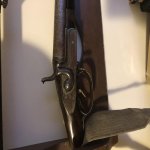 F49503CB-90A5-406E-8946-91090D5E454B.jpg46.1 KB · Views: 197
F49503CB-90A5-406E-8946-91090D5E454B.jpg46.1 KB · Views: 197 -
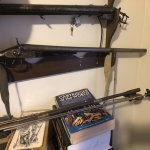 796B1549-E26E-4D2E-A456-75395DABE203.jpg70.7 KB · Views: 198
796B1549-E26E-4D2E-A456-75395DABE203.jpg70.7 KB · Views: 198 -
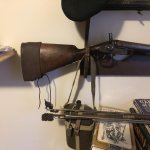 FDE41C4F-C9F5-4DAC-89E4-778ED27D47C2.jpg54.5 KB · Views: 198
FDE41C4F-C9F5-4DAC-89E4-778ED27D47C2.jpg54.5 KB · Views: 198 -
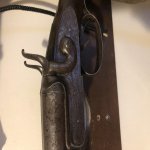 12885C03-A281-43E9-9041-ADBE18F6A2E0.jpg49.6 KB · Views: 196
12885C03-A281-43E9-9041-ADBE18F6A2E0.jpg49.6 KB · Views: 196 -
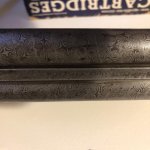 4ED596C3-6B8E-4AD6-AE07-270697E87951.jpg56.2 KB · Views: 198
4ED596C3-6B8E-4AD6-AE07-270697E87951.jpg56.2 KB · Views: 198
Last edited:
Londonshooter
CGN frequent flyer
- Location
- SW Ontario
Has hooks on the firing pins that hook into the back of the hammers. When you put the hammers on half #### the pins are retracted!!. Thumb opening.
Now that's quite a rare bird!
Londonshooter
CGN frequent flyer
- Location
- SW Ontario
Beauties, Ashcroft.A few group photos today. Some of my favourites-today.






































































